In the third post of “Tensile behaviour of UHPC” we start talking about UHPC…, finally 🙂 Don’t miss the two previous posts dealing with tensile properties of plain concrete and some important properties of it, such as scale-effect and brittleness. In this post we talk about (i) the reason underlying the use of fibres in concrete; (ii) the mechanical response of fibre-reinforced concretes and how it differs from plain concrete; and (iii) we show a typical constitutive behaviour of UHPC. Enjoy it !!
The use of fibres: a little bit of history
The invention of Portland cement 1824 by Joseph Aspdin triggered a construction technology revolution using what we currently call ‘concrete’. It was a cheap and easy to manufacture material with a huge potential to build structures. Engineers soon realised that and tried to find suitable applications for it. Yet they also realised they needed to solve two major problems: (i) its low tensile strength and (ii) its brittleness. What did they propose?
One of them should have thought: ‘What if we put inside concrete a continuous structure of a more capable material in tension, let’s say iron or steel? As concrete can’t provide the ductility and tensile strength required, let this inner structure do that job. If we did that, then concrete would contribute with those properties in which it is really good: (i) protection of the continuous iron or steel structure and (ii) compressive strength’.
This is the concept of ‘reinforced concrete‘ which was successfully introduced at the end of the 19th century. Thanks to that, concrete has become the construction material per excellence since then. Note that the concept of reinforced concrete works over the structural ductility. We don’t care whether concrete itself is britlle; we just want the structure to behave ductile.
In that context, another engineer could have thought that it was a better solution to work over material ductility. ‘How could I make concrete a more ductile material?’ – one should have thought.
Let’s bring to light the following patent developed in 1874 by Ahoille Berard in Oakland, California. It claimed the invention of a new artificial stone formed by mixing two parts of gravel, two parts of sand, two parts of hydraulic lime, one part of granular waste iron and water enough to make the mixture of the consistency of a mortar. What really draws our attention is the use of the granular waste iron. Why did he use that? Despite I have little information about the grinding size and shape of that waste iron, it could have been used as a discontinuous iron reinforcement added to what could be called a “primitive concrete” to confer ductility properties to it. This reinforcement might have been supposed to sew small cracks providing a remarkable increase of ductility to concrete. I don’t really know if he achieved that, but this is definitely the concept of ‘fibre reinforced concrete‘ (FRC) as we know today.
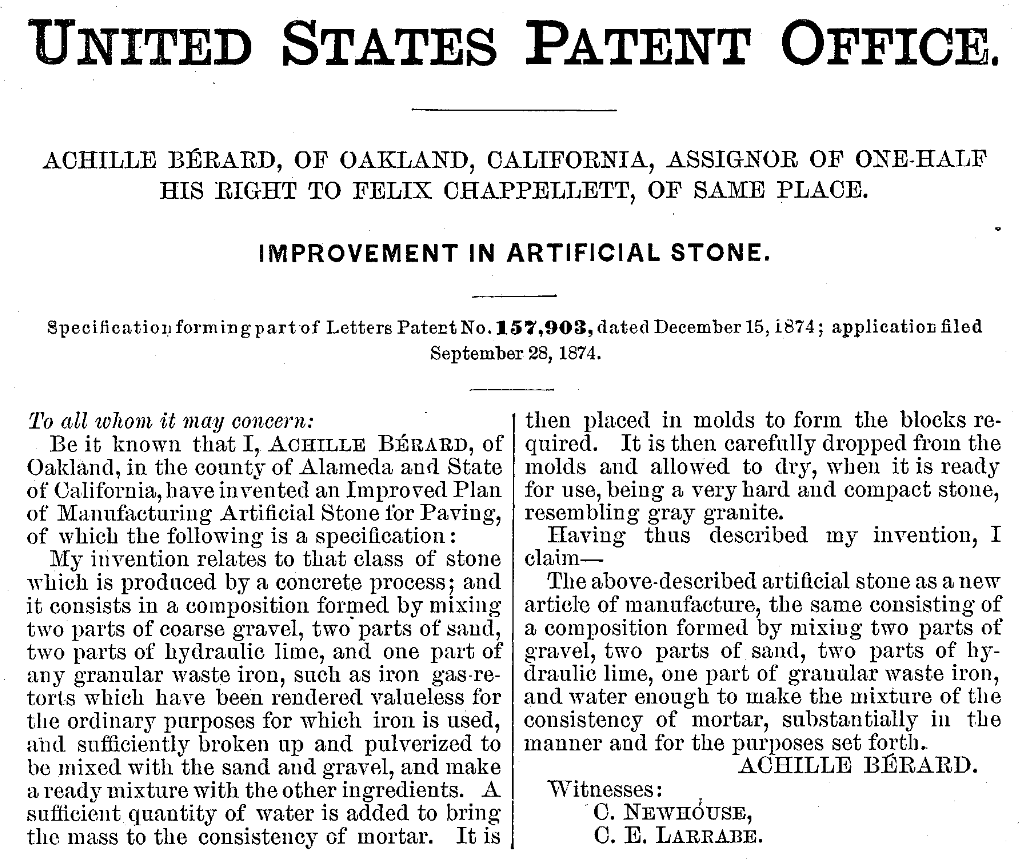
The failure of a promising idea
Far from being as succesful as ‘reinforced concrete’, FRC technology found its larger application field in the early years of the 20th century in thin elements made with asbestos fibre-reinforced mortar. However, its use decayed once it was discovered that the prolonged inhalation of asbestos fibers can cause serious and fatal illnesses. It was necessary to wait until the 1990s to find an increasingly widespread use of fibre concrete in engineering applications. What happened then?
In the 1990s, the fibre-reinforced concrete topic was in fashion. Fibre production technology greatly improved and fibre suppliers increased all over the world lowering its price. Besides, more than 1,000 scientific publications came to light dealing with fibre effect, FRC properties and production technology. It seemed as if a FRC boom was about to start. But it didn’t 🙁
The price of fibres was still too high which forced to keep the total amount of fibres limited to 40 kg/m3 to be competitive. This fact doesn’t just restraint the huge potential of fibres but greatly increases the variability of its mechanical response. And there is nothing worse for an engineer than variability. It leads to very low characteristic strength values, which means nothing in design. Lack of reliability was the reason for which FRC was poorly perceived by engineers. It masked all the benefits of fibres and showed a kind of unpredictible response. The use of fibres can’t be justified at all for most structural applications. That delayed, again, a more extensive use of fibres.
Nowadays, this situation has changed for the better. Fibres are more efficient and cheap. Besides, having the length and slenderness ratio suitable for both our structure and concrete mixture is now a reality !! A fibre amount of around 80-160 kg/m3 is currently competitive for several structural applications. In this range (and above), variablity can be kept in suitable ranges for design. Moreover, knowledge of fibre-reinforced concrete and the technology to produce it is now within reach. It is now possible to design and manufacture reliable and competitive structural elements using any type of FRC !! Time for fibres has finally come !!
What do fibres provide to concrete?
- Reduction of concrete brittleness
- Increase of flexural and tensile strength
- Indirect increase of stiffness
- Improvement of crack control
- Confinement of steel rebars
- Indirect improve in durability and long-term behaviour
- Improvement in fatigue and impact performance
- .
- .
- .
- Anything else? 😉
Despite fibres play an important role in concrete performance properties, it is very important to remember that, in most structural elements, fibres can’t replace main tensile reinforcement. Yet all minimum reinforcements and certain secondary reinforcements can be dispensed with. The above mentioned performance properties of FRC lead to a reduction of the dead load of structures, resulting in slenderer designs; smaller amount of raw materials; a reduction of amount of rebars used; prolonged service life of structures; reduced maintenance costs; etc. In some way, the use of fibres contributes to sustainiability.
Don’t missunderstand it !! FRC is not to be seen as an alternative to ‘reinforced concrete’, but rather as a complement to it.
And where does that leave UHPC? By definition, UHPC is a high compressive strength concrete which must contain a minimum amount of fibres (FRC) to achieve a minimum material ductility because such a high compressive strength leads to a rather brittle response, which require a certain degree of material confinement. Apart from that, a reliable use of tensile response of any FRC requires a minimuma amount of fibres of around 60-80 kg/m3, whatever its compressive strength. Otherwise, its high variability is going to penalise tensile performance in design too much. Above this value, tensile behaviour of UHPC and FRC doesn’t have to be too different. Differences between them will depend mainly on type of fibre, amount and fibre to matrix bond. And what’s more, it is not going to be too different evene from tensile behaviour of plain concrete (in shape). Let’s describe the tensile behaviour of FRC.
Tensile behaviour of FRC
Conceptually speaking and from a mechanical point of view, UHPC tensile response is not quite different from conventional FRC, or even plain concrete one. If a uniaxial tensile test is carried out on whatever type of FRC specimen, the shape of the force versus displacement curve is going to be similar to that for plain concrete. The difference is just found in the total energy absorbed up to a complete unloading process. Do you remember the three stages in the tensile response of plain concrete? Take a short look to our previous post to refresh it.
The tensile strength of any concrete (with and without fibres) can be divided in three main stages. Take a look at the following picture. It compares the tensile behaviour of plain concrete (left) to a typical tensile behaviour of UHPC (right). Not too different, right? 😉 The three stages can be clearly seen in both of them.
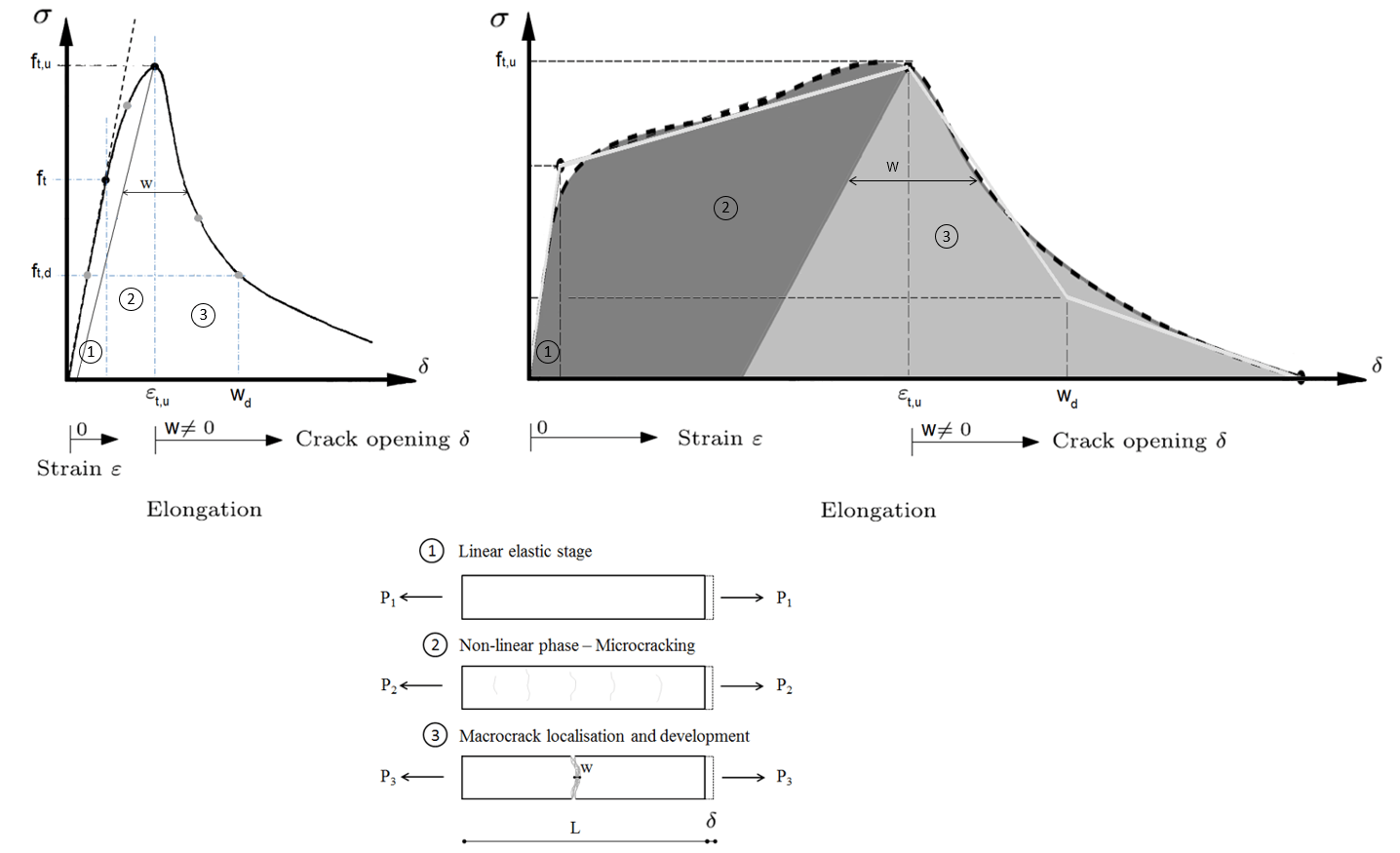
Left. Edited picture from: Petersson, P. (1981). Crack growth and development of fracture zones in plain concrete and similar materials. PhD Lund Universitiy. Division of Building Materials Lund Institute of Technology.
Right. Edited picture from: Wille, K., El-Tawil, S., & Naaman, A. (2014). Properties of strain hardening ultra high performance fiber reinforced concrete (UHP-FRC) under direct tensile loading. Cement and Concrete Composites, 48, 53-66.
Stage I corresponds to the linear elastic stage and is characterised by the elastic modulus (E) and the cracking strength (ft), which depends mainly on compressive strength and less on fibre type and amount. The higher the compressive strength or amount of fibre, the higher the cracking strength but keeping always the linear shape.
Stage II is characterised by a non-linear behaviour due to microcracking. It also appears in plain concrete, but with less intesity. Tensile strength (ft,u) is close to cracking strength (ft) and it is only clearly higher when fibres work as a continuous reinforcement, i.e. when using a large amount of them. The most important parameter in this stage is the strain reached at the end of it (εt,u). We can distinguish between those concretes in which the characteristic value of ‘εt,u‘ is higher enough to be considered in design (ductile hardening concretes) and those in which is not (plain concrete and ductile softening concrete). In the latter case, the difference between FRC and plain concrete is found only in the Stage III. See following picture for a better understanding of it.
The three main parameters that determine the existance of hardening behaviour are: (i) fibre amount; (ii) fibre to matrix bond; and (iii) fibre orientation. As fibre orientation is a structural parameter, whether we can use hardening behaviour in design not only depends on the type of concrete we have, but also on the element type and pouring procedure followed.
Stage III is the softening phase. The area under it is called fracture energy. It also exists in plain concrete, but its value is very low if compared to any FRC. This behaviour mainly depends on fibre type, fibre to matrix bond and also on fibre orientation.
At the end, tensile properties of any concrete can be described using the previous constitutive law. The characteristic values taken for each parameter and expected fibre orientation coefficient determine the tensile law used in design. Let’s see some examples.
NOTE: The following constitutive law represents design laws and are not to scale. Remember that tensile constitutive behavoiur of any concerte can be described using the three stages described above. In the following picture tensile behaviour has been simplified, neglecting the stages that are not relevant for design purposes.

- a) It corresponds to plain concrete. Both hardening behaviour and fracture energy are so small that have no influence on the final design outcome. That’s why they are neglected in all design codes. Only the tensile strength (ft) is used in certain cases, e.g., for crack with check or prestressing design in service limit state. It can also be found in those fibre-reinforced concrete structures with unfavourable fibre orientation when using a small amount of fibres.
- b) It corresponds to a conventional fibre-reinforced concrete with a relatively low fibre content, but higher than 60 kg/m3 as a reference value. A minimum ductility performance is required for these concretes. If that is not accomplished, it has to be treated as plain concrete. The softening behaviour can be used in design to: (i) dispense with minimum reinforcement; (ii) dispense with the whole or part of shear reinforcement; (iii) decrease flexural reinforcement; (iv) obtain smaller crack openings; … Be careful with the last one !! We recommend not considering fibre contribution if crack opening is larger than 0.1 mm !!
- c) It corresponds to fibre-reinforced concrete with a relativeley high amount of fibres, very good fibre to matrix bond and favourable fibre orientation in the structural element. That ‘favourable‘ condition may be found in 1D and 2D elements and must be properly quantified !! This behavoiur is characerised by a multi microcracking stage at structural level thanks to the concrete ability to ‘yield ‘ (form a stable microcracking pattern). Having hardening structural behaviour let us to: (i) design structures withouth rebars (material is ductile at structural level); (ii) reach high strain values withouth cracking (just microcracking); (iii) increase the structural stiffness in service limit state; (iv) reduction of prestressing in service limit state; (v) use high yield strength rebars; (vi) greatly increase material shear strength; (vii) reduce lap and anchor length; …
- d) There may be some structural elements or regions with a softening (or even brittle) behaviour despite using a ductile hardening concrete due to an unfavourable fibre orientation. In those cases, tensile properties in design has to be limited. This limitations should be found in codes in the near future to avoid unexpected problems in structures. Those are the cases of corners, 3D elements, points of localised strain, perpendicular axis to a prevailing fibre orientation direction, …
At the end of day we can draw the two following main conclusions:
Material tensile behaviour of any concrete (with or withouth fibres) can be modelled using the same law in shape defined by 3 main stages: (i) linear elastic; (ii) non-linear behaviour due to microcracking ; (iii) softening
According to the degree of importance and variability of each stage, material tensile behavoiur can be simplified for design
Typical material response of UHPC in tension
First of all, let me clear out that, as happen with concrete compressive response, there is no intrinsic material behaviour in tension for concrete. Yes, we have been deceived our whole lifes !! The thing is that any strength property in concrete depends mainly on the element shape and size, the nature of load and loading rate. There is nothing intrinsic, so how have engineers solved this problem for design? When we design structures we don’t use the real mechanical behaviour of our material, but a representative and guaranteed one. In case the structural behaviour of any region or element is far from that, codes provide correction coefficients to take it into account. During construction, we have to ensure that these representative behaviour is reached in the material used to build the structure by means of standard specimens and tests.
As there is not available an internationally accepted standard test that let us obtain a complete (the 3 stages) tensile behaviour for any FRC, it is essential to describe the test used to obtain tensile response of our FRC. Otherwise, information is useless !! Tensile response may vary a lot depending on the test and specimen used !!
That said, it is mandatory to say that following tensile response corresponds to a UHPC with 170 average compressive strength and 2% of 13/0.2 steel fibres tested under a 450-mm span unnotched third (not three)–point flexural test using a prismatic specimen 100 x 100 x 500 mm. Tensile response was derived from that test. Material constitutive tensile response of a single specimen is shown in the following picture (top). UHPC results are compared to the tensile behaviour of plain concrete (C30) according to Model Code 2010 (bottom). On it you can see the difference in size but not in shape between UHPC and plain concrete 🙂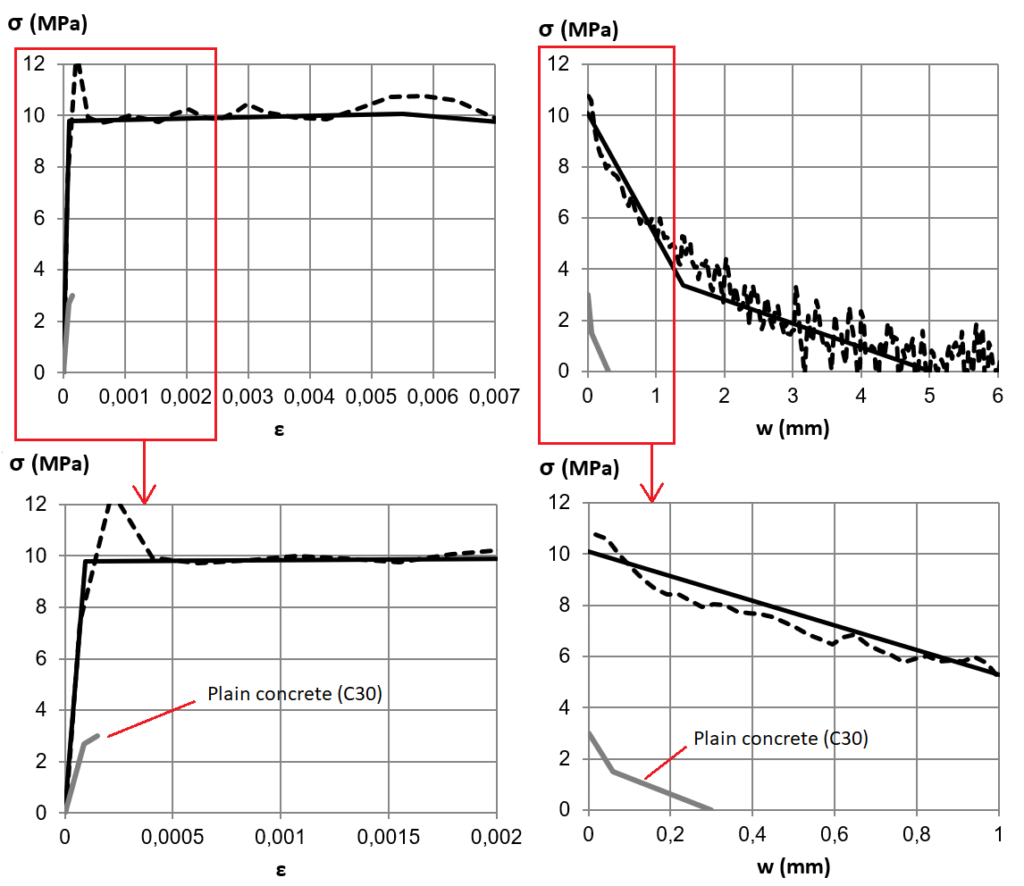
At this point, one question arises that has no easy answer. If UHPC tensile behaviour is similar (in shape) to that of FRC or plain concrete, why don’t we have a single code encompassing all concretes? The reason may be found in the fact that unifying everything we have learnt along history and new type of concretes and technologies requires such a thorough work and a complex international agreement that we’d rather start over a new code than trying to offer a general picture of the current state ot the art. If we were to do that, it would be probably a good start to find a suitable mechanical classification that encompassses all types of concretes. Model Code 2010 tries to do that, but does it include hardening behaviour? Let’s leave that for the next post 🙂 !!

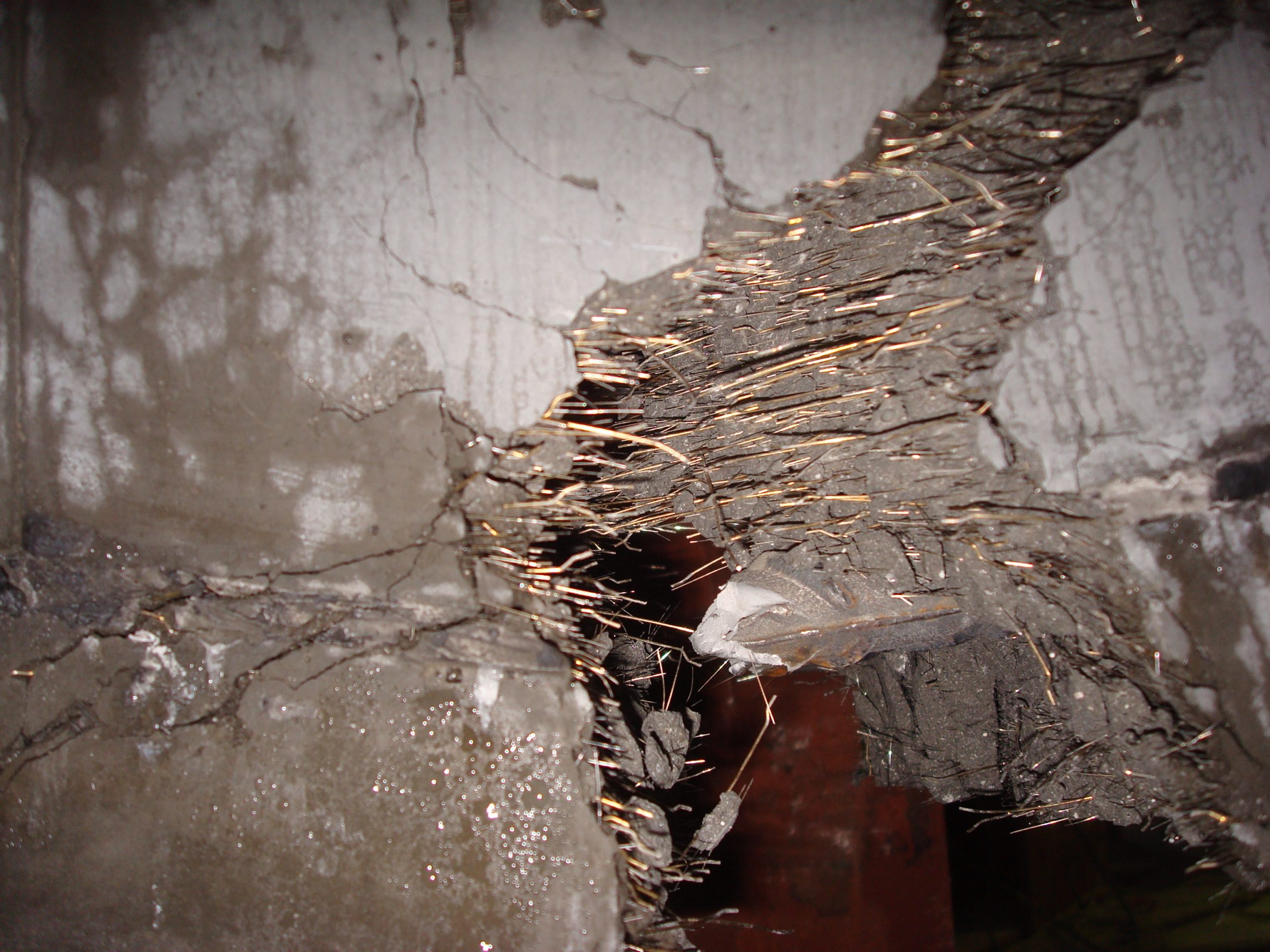

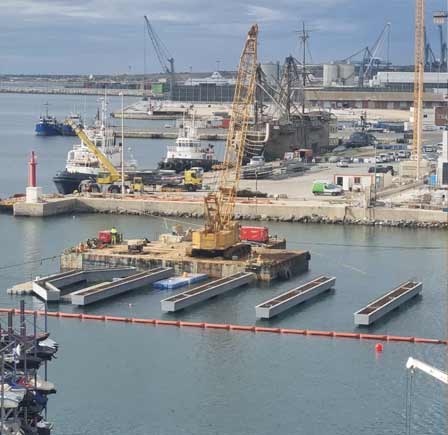
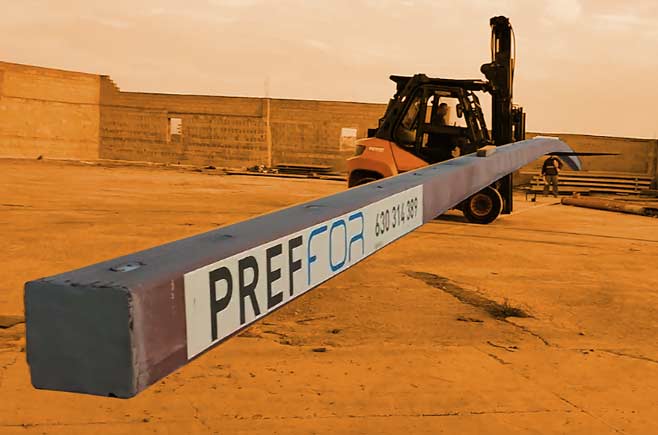

One Response
This is really nice article. Fibres have a lot of benefits in the concrete. Its really good to know and the stages are showing nice results.
Comments are closed.